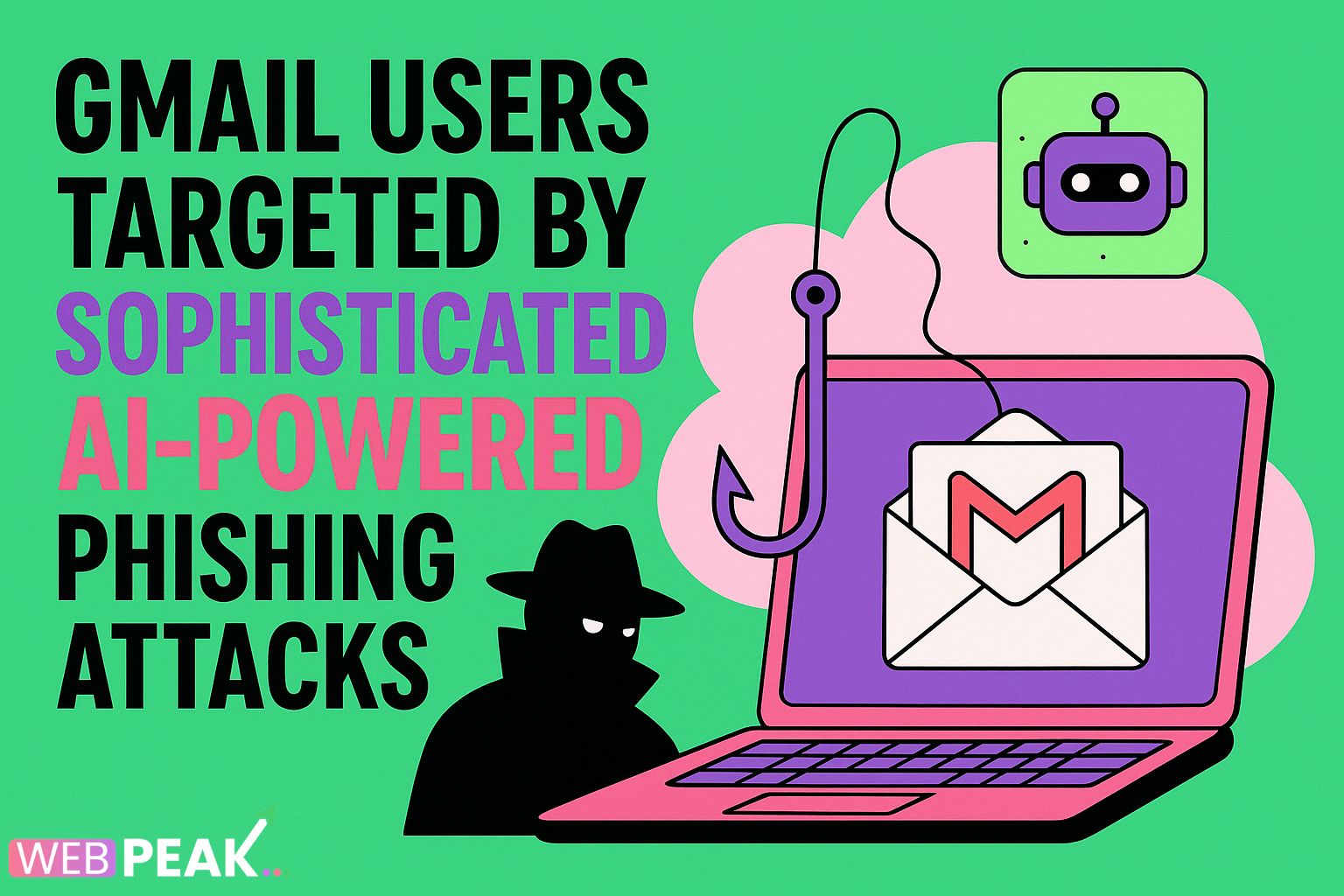Gmail Users Targeted By Sophisticated AI-Powered Phishing Attacks
Gmail users are increasingly being targeted by a new wave of AI-powered phishing attacks that are more advanced, more convincing, and harder to detect than traditional scams. These attacks are engineered using artificial intelligence tools capable of mimicking human writing patterns, generating personalized messages, and bypassing conventional spam filters. Within the first 100–150 words of this article, it’s important to stress that Gmail users targeted by sophisticated AI-powered phishing attacks are facing a rapidly evolving cybersecurity threat—one that requires awareness, strong defenses, and proactive digital hygiene.
This in-depth guide explores how these AI-driven attacks work, why Gmail users are being targeted, the tell-tale signs of these phishing attempts, and actionable steps individuals and businesses can take to protect themselves. You'll also find an SEO-focused checklist, best-practice frameworks, and a helpful FAQ section to strengthen your cybersecurity posture.
Understanding the Rise of AI-Powered Phishing Attacks
Phishing has existed for decades, but the combination of artificial intelligence, automated content generation, and machine-learning algorithms has introduced a new level of sophistication. Attackers no longer need to manually craft emails. Instead, they use AI systems capable of:
- Analyzing social media profiles to personalize messages
- Scraping publicly available data from websites
- Generating highly realistic emails that mimic real brands and colleagues
- Creating multilingual content without spelling or grammar mistakes
- Bypassing Gmail's built-in security filters by using unique, AI-generated patterns
Why Gmail Users Are a Primary Target
Google’s Gmail platform holds over 1.8 billion active users, making it the largest email provider worldwide. Cybercriminals prefer targeting Gmail users because:
- Gmail is widely used by both individuals and businesses.
- Account integrations (Google Drive, Docs, Photos, YouTube, Analytics, etc.) provide multiple access points.
- Compromised Gmail accounts are frequently used to execute secondary attacks.
- Gmail login credentials are in high demand on the dark web.
The combination of global adoption and account-level interconnectedness makes Gmail a particularly lucrative target for AI-enhanced phishing campaigns.
How AI-Powered Phishing Attacks Work
AI-driven phishing attacks follow a predictable yet highly effective structure. Attackers rely on AI tools to automate tasks that previously required manual effort. Here's a breakdown of how these attacks typically operate:
1. Data Harvesting and Target Profiling
Before launching an attack, cybercriminals gather personal information through:
- Social networks
- Leaked databases
- Publicly accessible emails
- Web scraping tools
AI systems then analyze this data to generate highly targeted content that appears authentic and specifically tailored to the recipient.
2. AI-Generated Email Crafting
Using LLMs (Large Language Models), attackers craft:
- Emails impersonating Google Support
- Password reset warnings
- Suspicious login alerts
- Fake Google Drive file-sharing notifications
- Invoices or financial requests
These emails are nearly indistinguishable from legitimate Gmail notifications.
3. Realistic Phishing Pages Generated by AI
AI tools are also used to generate cloned Google login pages. These webpages:
- Use accurate branding
- Have SSL certificates (making them appear secure)
- Capture email credentials instantly
4. Automated Credential Theft and Account Access
Once a user enters their login information, attackers:
- Gain immediate access to their Gmail
- Attempt to access linked Google services
- Change security settings
- Launch further phishing attacks from the compromised inbox
5. AI-Driven Evasion Techniques
Attackers now use AI to avoid detection by:
- Generating unique content that spam filters can’t match to known patterns
- Rotating domain names automatically
- Mimicking normal user behavior to avoid triggering security flags
Common Signs of AI-Powered Phishing Emails Targeting Gmail Users
While AI phishing attacks are harder to spot, there are still red flags users should look for.
- Unfamiliar login alerts that request immediate password changes
- Messages claiming suspicious account activity
- Emails urging urgent action, such as account closure warnings
- Links that appear slightly modified (e.g., g00gle.com instead of google.com)
- Email addresses with unusual characters
- Unexpected file-sharing invitations
AI attackers capitalize on urgency, tone mimicry, and realistic formatting to lower the recipient’s guard.
Real-World Examples of AI-Driven Gmail Phishing Attempts
Several recent phishing waves have demonstrated how advanced these attacks have become:
Fake Google Account Recovery Notices
Emails claim suspicious login attempts from foreign IPs, urging users to “secure their account.” The embedded link leads to a cloned login page.
AI-Generated Google Workspace Alerts
These target business Gmail users, spoofing admin notices stating that storage accounts, user permissions, or billing information require updates.
Spear-Phishing Through Gmail Contact Lists
Once attackers access one Gmail account, they use AI to generate personalized messages to the victim’s friends and coworkers.
How Gmail Users Can Protect Themselves From AI-Powered Phishing
Cybersecurity awareness is the first line of defense. Here are essential measures users can take:
1. Enable 2-Step Verification (2FA)
Google strongly recommends 2FA through:
- Google Prompt
- Authenticator apps
- Physical security keys
2. Verify Email Senders Carefully
Check for:
- Exact spelling of the sender’s address
- Extra characters or unusual domain names
3. Never Click Suspicious Links
Hover over links to preview the full URL. If it doesn’t lead to Google.com or accounts.google.com, avoid it.
4. Use Gmail’s Enhanced Security Mode
Google Workspace and personal accounts can activate enhanced protection to block harmful sites automatically.
5. Update Passwords Regularly
Use strong, unique passwords, preferably via a password manager.
6. Report Phishing Emails
Users can select “Report phishing” in Gmail to help improve the platform’s detection algorithms.
SEO Checklist: Targeting Keywords Related to AI Phishing & Gmail Security
Below is a comprehensive SEO checklist to help maximize search visibility for this topic:
- Use the primary keyword “AI-powered phishing attacks” in H1 and introduction.
- Include related keywords like “Gmail security threats,” “AI cyberattacks,” and “Google phishing scams.”
- Write at least 1500+ words of high-quality, original content.
- Use scannable headings (H2/H3) with varied keyword placements.
- Add bullet points for readability.
- Insert a contextual internal link (if applicable).
- Ensure meta description length is 150–170 characters.
- Optimize for intent by including a FAQ section.
- Use natural keyword variations throughout the article.
- Ensure mobile-friendly readability with short paragraphs.
FAQ: Gmail AI Phishing Attacks
1. What is an AI-powered phishing attack?
AI-powered phishing occurs when cybercriminals use artificial intelligence tools to create realistic emails, messages, and login pages designed to steal sensitive information like Gmail passwords.
2. Why are Gmail users being targeted?
Gmail’s massive user base makes it an attractive target. Attackers also exploit Google’s integration ecosystem to gain access to multiple connected services.
3. Can Google detect AI-generated phishing emails?
Google's spam filters are advanced, but AI-generated messages often bypass detection because they use unique, human-like patterns that aren't easily matched to known phishing templates.
4. How can I verify if an email is truly from Google?
Check the sender domain (must be @google.com), avoid clicking suspicious links, and navigate directly to your Google account dashboard instead of interacting through email.
5. What should I do if I clicked a phishing link?
Immediately change your Gmail password, enable 2FA, review account activity, and revoke access to suspicious third-party applications.
6. Are AI phishing attacks becoming more common?
Yes. With AI tools becoming widely accessible, attackers can produce more phishing emails faster and with greater realism than ever before.
Final Thoughts
The rise of AI-driven phishing represents one of the biggest emerging cybersecurity challenges for Gmail users worldwide. By understanding how these attacks work and following best practices, individuals and businesses can significantly reduce their vulnerability. Staying informed, remaining cautious, and applying consistent security habits are the keys to staying safe in an era of intelligent cyberthreats.
For organizations looking to strengthen their digital infrastructure against evolving online threats, WEBPEAK offers full-service digital marketing solutions, including Web Development, Digital Marketing, and Artificial Intelligence Services.





